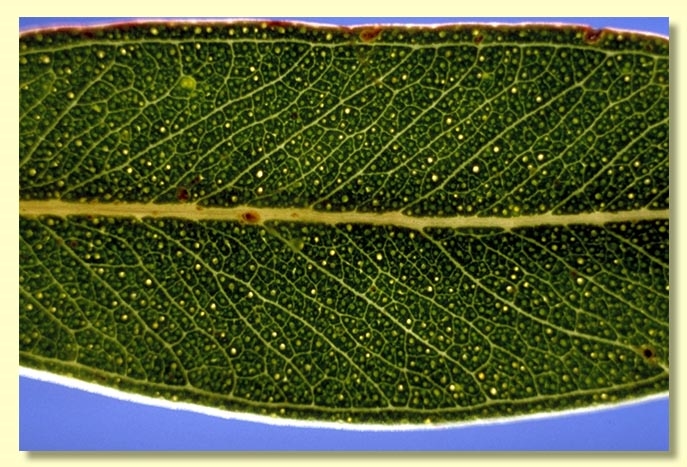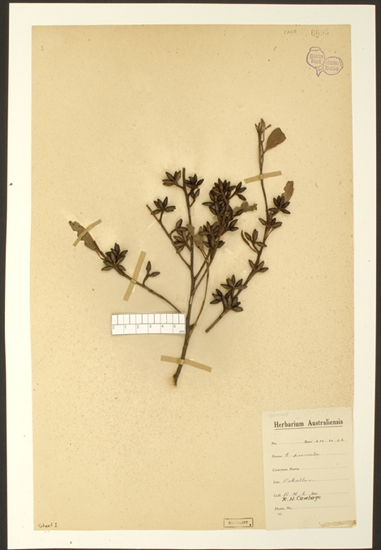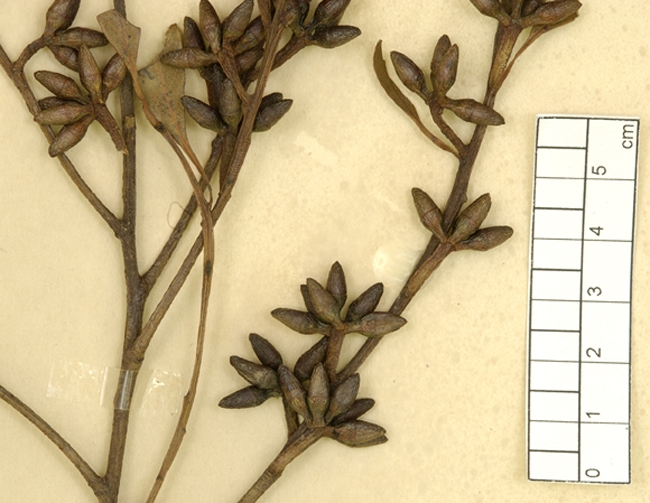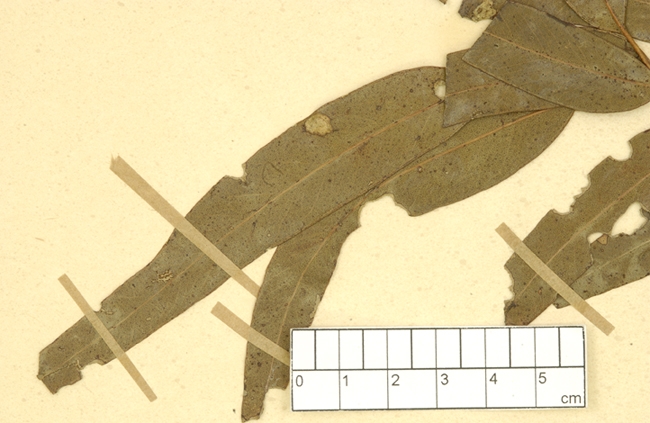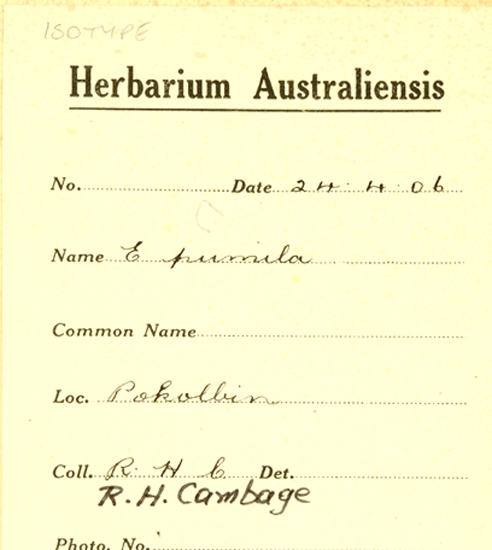Euclid - Online edition
Eucalyptus pumila
Eucalyptus | Symphyomyrtus | Pumilio
T: Pokolbin, NSW, 24 Apr. 1906, R.H.Cambage s.n.; syn: CANB, NSW.
Bark smooth, grey to pink, yellow-green, brown, cream or white, shedding from stems in ribbons.
Juvenile growth (coppice or field seedlings to 50 cm): stems rounded in cross-section; juvenile leaves always petiolate, opposite for ca 4 nodes then alternate, ovate, to 10 cm long, 6 cm wide, base rounded to tapering, dull, green.
Adult leaves alternate, petiole 0.8–2 cm long; blade lanceolate to falcate to elliptical, 5–16 cm long, 1–3 cm wide, base tapering to petiole, concolorous, slightly glossy or dull, green to blue-green, side-veins greater than 45° to midrib, moderately reticulate, intramarginal vein parallel to and just within margin or remote from it, oil glands mostly island.
Inflorescence usually axillary unbranched but occasionally compound and terminal with a terminal vegetative bud that grows out, peduncles stout, 0.6–1.5 cm long, buds 7 per umbel, normally pedicellate, rarely sessile (pedicels (0)0.2–0.5 cm long). Mature buds oblong to ovoid (0.7–1.1 cm long, 0.4–0.6 cm wide), green or red, scar present, operculum bluntly or acutely conical (ca 4–8 mm long), stamens mostly inflexed with a few very short inner stamens erect, anthers cuboid to oblong, versatile, dorsifixed, dehiscing by longitudinal slits (non-confluent), style long, stigma blunt to rounded, locules usually 3 or 4, the placentae each with 4 vertical ovule rows. Flowers white.
Fruit pedicellate (pedicels 0.1–0.3 cm long), hemispherical or cup-shaped, 0.4–0.6 cm long, 0.7–0.9 cm wide, disc usually raised-annular or level, valves usually 4, strongly exserted.
Seeds black, 1–2.2 mm long, ovoid or flattened-ovoid with faint ventral ridges, dorsal surface pitted, hilum ventral.
Cultivated seedlings (measured at ca node 10): cotyledons bilobed to oblong; stems rounded in cross-section; leaves always petiolate, opposite for 3 nodes then alternate, ovate, 5–9 cm long, 2–4.5 cm wide, base tapering, more or less concolorous, dull, green.
Flowering has been recorded in February, April, June and August.
Occasionally grown as a small ornamental.
A small mallee known from only two localities, on sandstone on the northern slopes of the Broken Back Range and Singleton army base immediately to the north, between Broke and Pokolbin north-west of Sydney, New South Wales. Closely related to no other species, it is smooth-barked, has petiolate juvenile leaves, falcate green glossy adult leaves and buds seven per umbel.
Eucalyptus pumila is the only species in Eucalyptus subgenus Symphyomyrtus section Pumilio. It occupies this unique position because of the following combination of characters: smooth bark, buds with two opercula, inflexed stamens and ovules in four rows, seeds more or less flattened-ovoid but slightly angular, cotyledons bilobed to oblong, adult leaves concolorous and fruit with exserted valves.
It flowers profusely in cultivation. Some plants at the army base site and in cultivation at the Australian Nation Botanic Gardens, have a profuse terminal infloresence which eventually produces new vegetative growth at the tip, compared with the more usual simple axillary umbels. The plants otherwise look the same and the arrangement of structures inside the flower buds is constant so these plants are unlikey to be hybrids but simply different morphs.
Eucalyptus pumila is listed as "Vulnerable" under the Australian Government Environment Protection and Biodiversity Conservation Act 1999 (EPBC Act). Further information may be found at this web address:
http://www.environment.gov.au/cgi-bin/sprat/public/sprat.pl




